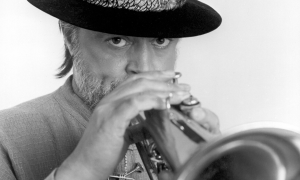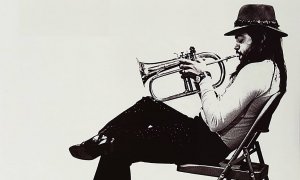Home » Jazz Articles » Catching Up With » Camille Bertault: The Fine Art of Breaking Jazz Conventions
Camille Bertault: The Fine Art of Breaking Jazz Conventions

Courtesy Thomas Braut
I have come to realize that I love songwriting. Being a singer is not enough for me. When I compose a song and when I am on stage I feel like a story-teller.
—Camille Bertault
All About Jazz: Le Tigre is an exceptionally intense and diverse record. It blends classical, jazz, pop, rock and Brazilian music. How did you manage to combine all these influences so seamlessly?
Camille Bertault: Combining different genres and influences comes very natural to me. I did not set out to deliberately cover different genres. It just happened as I tried to create something that felt very close to me, where you can have a reggae groove against my classical imprinting.
AAJ: How does this album fit in your artistic evolution?
CB: I have come to realize that I love songwriting. Being a singer is not enough for me. When I compose a song and when I am on stage I feel like a story-teller. I wanted to avoid relying on the usual things, like scatting and improvising. I left them all behind and focused on my feelings and perceptions. I am now making my own music and singing my own lyrics and that is all. If I want to improvise, I do it, but not as a jazz aesthetic strategy. I do not know what will happen in the future; everything can change. But I feel that this way of creating music reflects who I am today.
AAJ: "There's a bird in my heart / That wants to fly away." In this album your compositions are very visual, they feel like musical paintings. Is this how you conceived them?
CB: For that song I was inspired by "Bluebird," a poem by Charles Bukowski. I liked this image of a beautiful bird that was trapped and wanted to get out. I wrote my own version of the poem in French and then I translated it into a song. In general, my way of creating art is really connected with the visual dimension, I like to tell stories through visions and pictures.
AAJ: How much does your theater background have to do with this, and more generally with how you compose your songs?
AAJ: I have studied theater, and so this art-form is definitely central to my work. I also remember that, when I was a little girl, my mum used to read me stories. In my childhood, I spent a lot of time just staying in my room and imagining stories. And now, when I create music and I am on stage, I feel like am just expressing what I see in my visual world. It is like going back to my roots.
AAJ: And there is also a strong connection with the sense and presence of nature...
CB: It is funny that you say that because I did not realize it. When I was younger, I was going to the conservatory in Paris but I was living in the countryside. It was like inhabiting two different worlds. Perhaps, in this album I am coming back to that time.
AAJ: What were you listening to while recording Le Tigre?
CB: I was listening to a lot of Charles Mingus, I really love his music. I think it is because I used to play piano and I have this classical background. But I was also listening to '90s hip hop singers like Lauryn Hill, and to Q-Tip. And to albums which blend the French music tradition with Brazilian music. I have been definitely inspired by many different music genres and styles.
AAJ: On this album there are some elements of continuity with the previous ones—like producer Michael Leonhart or the presence of Christophe Minck on bass—but also many new collaborators like Jacky Terrasson on piano or Diego Figuereido on guitar. Which of these aspects prevailed, continuity or novelty?
CB: I think there is a good balance between continuity and novelty. I have great trust and confidence in my long-time collaborators but, at the same time, I wanted to try something new. The Brazilian influences are very central in my music right now, partly because I really feel the need to break away from jazz conventions. In my opinion, this approach was successful as it led to something completely new, even in my way of singing.
AAJ: What is your working method with Michael Leonhart? How did he contribute in giving shape to your artistic vision?
CB: When I started working onLe Tigre, I used to perform in New York regularly. I took the opportunity of being in New York to go to a studio and start working with Michael. He speaks French very well and this is very important to me as he understood each song and everything I wanted to express. We started working on a computer, without instruments, in order to shape the atmosphere I had in mind. I went to New York three times in a year to work with him. Finally, he came to Paris three days before the recording, we focused on each song, exchanging ideas and feelings. During the recording, Michael and I were really open to changes. He is not that kind of artist who writes everything in advance. I had to be elastic to work with him, but I like this working method.
AAJ: Diego Figuereido is one of your many Brazilian musical soul-mates. What is the root of your fascination for Brazilian music?
CB: I have been in Brazil many times but I was never able to play with Diego there as he works mostly in the USA. My love story with Brazil begins 10 years ago. I received a scholarship to go there and do some storytelling work. I stayed there for three months, I learned to speak Portuguese and established connections with many musicians and producers. The year after, I went back to play at a festival, which is where I met my current manager. I had the chance to meet the right persons at the right moments and started to play with important musicians. I have completely fallen in love with Brazilian people and culture. In the past ten years, I have gone there every three months or so, and since the pandemic started I haven't been there for a whole year. I really miss that country!
AAJ: Songwriting and improvisation are at the core of your music. How do you reconcile these two aspects?
CB: I think that artists have to be sincere. I can compose a song and I can improvise. I can turn to one or the other, depending on what I feel and need in a particular moment. If we are not true to ourselves, then it is hard to communicate with the others.
AAJ: Do you have a daily routine? How much time do you devote to composing music? And besides music, what are your other passions?
CB: We are living in extraordinary times because of the pandemic situation. Since I could not play live music, I started to learn other instruments: bass, double bass, drums and guitar. I did not want to sing for months. I am teaching a lot of masterclasses and playing on the piano. I am not really in the mood to create anything new. It is a strange sensation, but it is hard to have a daily routine in this phase.
AAJ: Your albums show a rare balance between deep and introspective compositions and songs that showcase your sense of humor, two foundational aspects of your personality. How much humor do you find in the jazz world?
CB: At the beginning, jazz music represented a way to escape life's hardship. At that time, there was a deep sense of humor in jazz. Now things are changed: in general, there is a tendency of jazz people to take themselves too seriously. I personally cannot really understand why. I could not go through life without humor, even in the hardest times.
AAJ: A turning point in your artistic career was the by-now-legendary Facebook video in which you scat over the changes of "Giant Steps," which went viral and made you an overnight sensation. What are the advantages and disadvantages of the internet for an emerging artist in your opinion?
CB: There are advantages and disadvantages in every aspect of life. In my case, that video went viral, I got a great visibility from it, and it completely changed my life in terms of opportunities. I cannot deny it. On the other hand, most people knew me only for that video, and they thought I can do only scat singing. It was not easy to change their expectations, but the situation is changing. I like it when people come to see me playing live music with certain expectations, and then they get surprised and happy for what they discover about me. I enjoy that that people are now thinking of me as a songwriter.
AAJ: During this month of March there are plenty of initiatives celebrating the contribution of women to the jazz world. In spite of the undoubted progress, we are still living in a society of pervasive white male supremacy. What does being a female artist mean to you today?
CB: When I create music, I forget that I am woman. When I collaborate with male musicians, I do not think about their gender. I have a high consideration of the fight for gender equality, but at the same time I think that we should not focus on gender. It is the same with race: when I meet a musician, I do not focus on his or her race or ethnicity. I am in front of a person, and I can only relate to him or her as a human being. As far as music goes, I am a musician before being a woman. It is my way of fighting this battle, but I respect every way of fighting it!
Tags
Catching Up With
Emmanuel Di Tommaso
Charles Mingus
Lauryn Hill
Q-Tip
Jorge Bento
Michael Leonhart
Christophe Minck
Jacky Terrasson
Diego Figuereido
PREVIOUS / NEXT
Support All About Jazz
 All About Jazz has been a pillar of jazz since 1995, championing it as an art form and, more importantly, supporting the musicians who make it. Our enduring commitment has made "AAJ" one of the most culturally important websites of its kind, read by hundreds of thousands of fans, musicians and industry figures every month.
All About Jazz has been a pillar of jazz since 1995, championing it as an art form and, more importantly, supporting the musicians who make it. Our enduring commitment has made "AAJ" one of the most culturally important websites of its kind, read by hundreds of thousands of fans, musicians and industry figures every month.





















